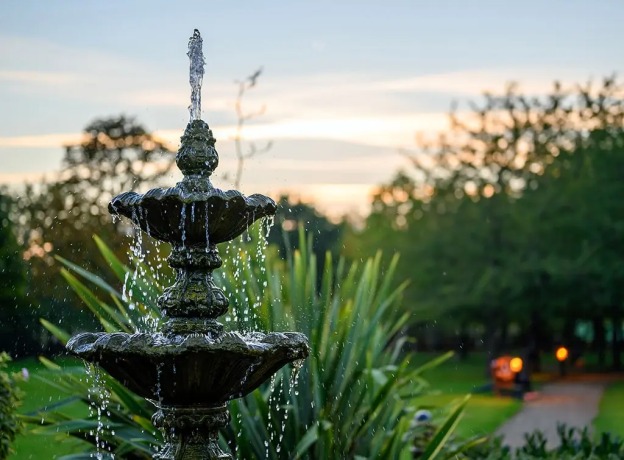The Ultimate Guide to Garden Water Features: Tranquil Outdoor Spaces
A beautiful garden offers more than just visual appeal; it provides a peaceful retreat from the hustle and bustle of daily life. One of the most impactful ways to elevate your outdoor oasis is by adding a water feature.
Whether it’s the soothing sound of a gentle stream or the playful trickle of a fountain, garden water features bring elegance, serenity, and even wildlife to your landscape
1. Benefits of Adding a Water Feature to Your Garden
A well-designed water feature doesn’t just enhance the look of your garden, it transforms your entire outdoor experience. Here are some compelling reasons to include one:
- Tranquility: The sound of flowing water promotes relaxation and reduces stress.
- Wildlife: Birds, butterflies, and frogs are naturally attracted to water sources.
- Curb Appeal: Increases property value by adding aesthetic charm.
- Microclimate: Adds moisture to the air, especially beneficial in arid climates.
- Versatility: Fits into any garden, regardless of size or style.
2. Types of Garden Water Features
Depending on your budget, space, and style preference, you can choose from a variety of water features:
Garden Fountains
Available in classic or modern designs, fountains can be freestanding or wall-mounted.
Ponds
Still or circulating ponds provide a habitat for fish and aquatic plants.
Waterfalls
Adds dynamic movement and sound, typically combined with ponds or streams.
Bubbling Rocks
A simple, low-maintenance option where water bubbles up through a decorative stone.
Solar Water Features
Powered by the sun, these energy-efficient options are environmentally friendly and easy to install.
3. Planning and Designing Your Water Feature
Before you begin installation, take some time to plan carefully.
Consider:
- Size of your garden: Smaller gardens may benefit from compact features like solar fountains.
- Sunlight availability: Crucial if you’re using solar-powered elements.
- Proximity to electrical outlets: For traditional powered water features.
- Style of your landscape: Modern, rustic, Japanese-inspired, etc.
- Safety: Especially if children or pets frequent your garden.
Sketch your layout to visualize where the feature will fit best and how it complements your garden’s overall design.
4. Tools and Materials You’ll Need
Here are some basic tools and materials commonly used when installing water features:
- Shovel or spade (for digging if needed)
- Level
- Pond liner (for ponds)
- Water pump or solar fountain
- Rocks, gravel, or bricks
- Tubing and connectors
- Waterproof sealant

5. How to Install a Garden Fountain
Here’s a basic step-by-step guide to installing a freestanding fountain:
Step 1: Choose a Location
Pick a flat, level spot with good visibility and proximity to sunlight (for solar features).
Step 2: Prepare the Base
Use bricks or a cement pad to create a stable foundation.
Step 3: Set Up the Pump
Install the water pump inside the base and connect the tubing to the fountain’s outlet.
Step 4: Fill with Water
Use a hose or bucket to fill the reservoir.
Step 5: Power It Up
If you’re using a solar-powered option like the Poposoap solar water fountain, ensure the solar panel is positioned for maximum sunlight exposure.
Step 6: Add Decorative Elements
Enhance with rocks, plants, or LED lighting.
6. Incorporating a Poposoap Solar Water Fountain
The solar water fountain is ideal for garden enthusiasts who want an easy, eco-conscious upgrade. These fountains require no electrical wiring or complicated setup. Simply place the solar panel in direct sunlight, and enjoy the fountain’s gentle flow.
Benefits:
- Eco-friendly: Uses solar energy, reducing electricity costs.
- Low-maintenance: Automatically shuts off when not in sunlight.
- Versatile: Works well in birdbaths, small ponds, or decorative basins.
- Portable: Easy to move and reposition.
Adding a Poposoap solar water fountain not only brings charm to your garden but also supports sustainable living with zero emissions and minimal upkeep.
7. DIY Pond Ideas on a Budget
Want a pond without spending a fortune? Try these DIY ideas:
- Pre-formed pond liners: Available at garden stores, easy to set up.
- Old bathtubs or containers: Convert them into mini ponds.
- Whiskey barrels: Create rustic water features with minimal excavation.
- Recycled materials: Use bricks or stones from old projects.
Combine these with a small solar pump and aquatic plants for an eco-friendly setup.
8. Waterfalls and Streams: For the More Ambitious
If you have a slope in your yard or want a dramatic feature, a DIY waterfall or stream can be a great project.
Quick Tips:
- Use gravity to your advantage—place the water source higher than the outlet.
- Hide the pump in a submerged basin or pond.
- Use natural stones to build the cascade.
- Add aquatic plants to soften edges.

9. Maintenance Tips for Long-Term Beauty
Even the most beautiful water feature will lose its appeal if not properly maintained. Here’s how to keep it pristine:
- Clean filters regularly: Prevent clogs and maintain water flow.
- Check for algae: Use natural treatments or UV clarifiers.
- Monitor water levels: Top up evaporated water, especially in summer.
- Clean pumps: Ensure debris doesn’t obstruct flow.
- Winterize: Remove pumps and store indoors in freezing climates.
10. Landscaping Around Your Water Feature
Enhance your garden’s ambiance by landscaping around your water feature:
- Plant Selection: Use moisture-loving plants like ferns, irises, or hostas.
- Lighting: Add solar or LED lights to highlight your fountain at night.
- Hardscaping: Use stones, bricks, or stepping paths for structure and accessibility.
- Seating Area: Place a bench or swing nearby for peaceful reflection.
11. Common Mistakes to Avoid
Avoid these pitfalls when adding a water feature:
- Poor planning: Not considering sunlight, size, or water access.
- Wrong pump size: Too small, and water won’t circulate properly.
- Skipping filtration: Leads to algae, stagnant water, and mosquito breeding.
- Overcrowding plants: Reduces oxygen and clogs the system.
- Ignoring safety: Secure edges and shallow areas for children and pets.

Wrapping Up :
Adding a water feature to your garden is one of the most rewarding upgrades you can make. Whether you choose a simple solar fountain, a DIY pond, or a cascading waterfall, you’re investing in tranquility, visual interest, and a deeper connection to nature.
Modern innovations like the Poposoap solar water fountain make it easier than ever to enjoy the benefits of water features without the environmental impact or complex installation. With proper planning, regular maintenance, and thoughtful landscaping, your water feature can become the centerpiece of your garden sanctuary for years to come.
Keep an eye for more latest news & updates on Ancient Artz!






